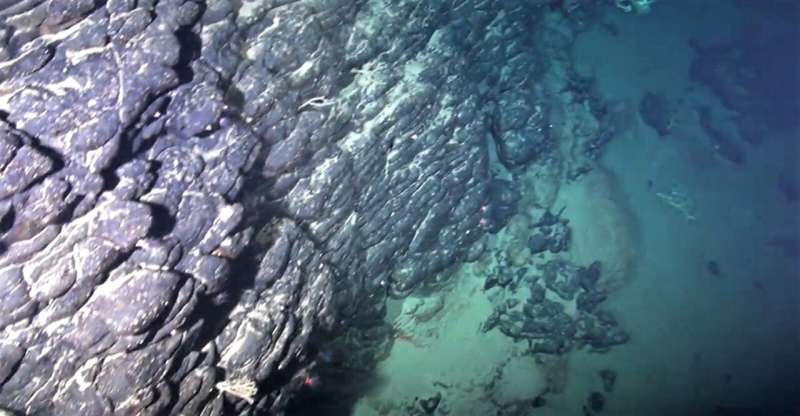Samples were collected during expeditions conducted in 2018 by researchers affiliated with the University of São Paulo (Brazil) and the University of Southampton (UK). This dark-gray rock is a volcanic basalt deposit. Credit: IO-USP
A study led by scientists at the University of São Paulo (USP) in Brazil has shown that the Rio Grande Rise (RGR), a possibly continental basaltic plateau and chain of seamounts now submerged in the South Atlantic Ocean some 1,200 km from the coast of Brazil, was once a giant tropical island, rich in minerals and covered with vegetation. Geologists have dated sediments from the formation to between 45 million and 40 million years ago.
The study, which involved almost 10 years of research, is published in the journal Scientific Reports with new information on the geology of the RGR, which has about the same area as Spain.
The researchers analyzed samples of sea floor sediment dredged at a depth of about 650 m in the western RGR and characterized its mineralogical, geochemical and magnetic properties. The samples contained mainly red clay with several minerals typical of tropical volcanic rock alterations, such as kaolinite, magnetite, oxidized magnetite, hematite and goethite.
In 2018, the group posited that the RGR was once an island, based on discoveries made by scientific expeditions to the region, where they collected a sample. They traveled on the Royal Research Ship (RRS) Discovery, operated by the United Kingdom's National Oceanography Center (NOC), and the Alpha Crucis, USP's oceanographic research vessel. The researchers were from USP's Oceanographic Institute (IO) and the University of Southampton in the UK.
"Our research and analysis enabled us to determine that it was indeed an island, and what's now under discussion is whether the area can be included in Brazil's legally recognized continental shelf. Geologically speaking, we discovered that the clay was formed after the last volcanic activity occurred 45 million years ago. The formation therefore dates from between 30 million and 40 million years ago. And it must have been formed as a result of these tropical conditions," Luigi Jovane, last author of the article and a professor at IO-USP, told Agência FAPESP.
For Jovane, the fact that a multidisciplinary team participated in the research contributed to the results. "We have a group of the highest quality including specialists in geology, geochemistry, biology, hydrodynamics, environmental impact assessment, new energies, psychology, and law. All this accumulated science can be used to deepen our understanding of the RGR and prospect the region without affecting the local system's synergies," Jovane said.
"To know whether resources can be viably extracted from the sea floor, we need to analyze the sustainability and impacts of this extraction. The ecosystem services provided by the ocean there haven't been studied in detail, for example. When you interfere with an area, you have to know how this will affect animals, fungi and corals, and understand the impact you'll have on the cumulative processes involved."
In 2023 alone, Jovane led the production of four other articles with results of studies involving volcanic rock and ferromanganese crust samples from the RGR. The articles are published in Frontiers in Marine Science, Journal of Materials Research and Technology, Geochemistry and Marine Geology.
More information: Priyeshu Srivastava et al, Red clays indicate sub-aerial exposure of the Rio Grande Rise during the Eocene volcanic episode, Scientific Reports (2023). DOI: 10.1038/s41598-023-46273-y
Provided by FAPESP























